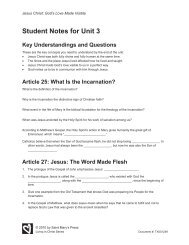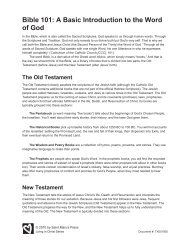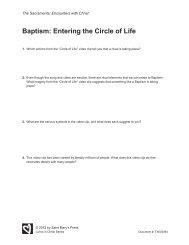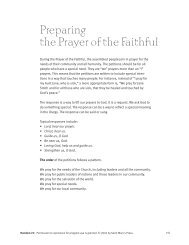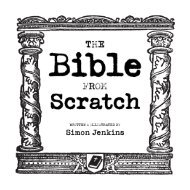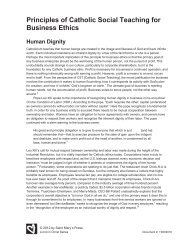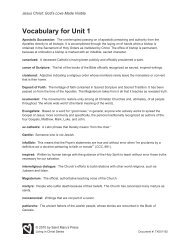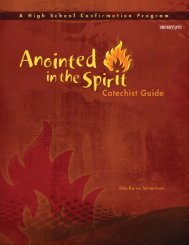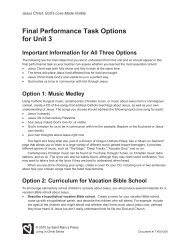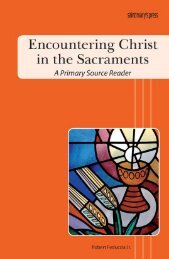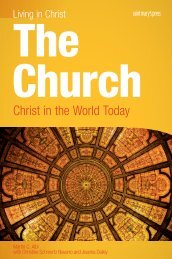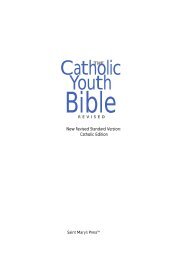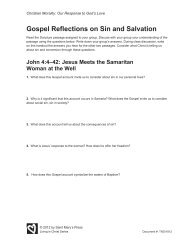ESSENTIAL BIBLE DICTIONARY - Saint Mary's Press
ESSENTIAL BIBLE DICTIONARY - Saint Mary's Press
ESSENTIAL BIBLE DICTIONARY - Saint Mary's Press
You also want an ePaper? Increase the reach of your titles
YUMPU automatically turns print PDFs into web optimized ePapers that Google loves.
SAINT MARY’S PRESS<strong>ESSENTIAL</strong><strong>BIBLE</strong><strong>DICTIONARY</strong>Sheila O’Connell-RoussellContributing AuthorBrian Singer-Towns<strong>Saint</strong> Mary’s <strong>Press</strong> ®
I dedicate this work to my granddaughter, Stella Noelle Richman, who is five yearsold today. I want her to know that she is part of God’s great love story for humanityand that one person living her truth can change the world forever.Dr. Sheila O’Connell-Roussell, grandmomFebruary 23, 2005AUTHORACKNOWLEDGMENTSLet me begin by offering thanksgiving to His Holiness Pope Pius XII, who, on September30, 1943, issued his now-noteworthy encyclical Divino Afflante Spiritu. Thisdocument directed Catholic scholars to explore the historical world of the inspired authorsof the Scriptures, thereby opening modern Scripture research to the Catholicworld. Much of what is contained in this dictionary would not be known today if notfor Pius XII’s vision.Thank you, Vicki! I so appreciate the beautiful drawings by artist Vicki Shuck ofBend, Oregon. They offer a rich variety of images for contemplation. The same Spiritwho guided the authors of the sacred Scriptures also inspires religious artists likeVicki.I have profound appreciation for my editor, Brian Singer-Towns, and his vision, direction,counsel, craft, and faith. Brian is far more than editor. He has spent manyhours encouraging and directing me and rewriting this text. Although gifted with holyhumility, he is truly my coauthor and partner in this work; its clarity reveals his skillfulhand. I’m also grateful for the dedication to detail and the beautiful work of editorGinny Halbur and her commitment to this project.I proclaim my love and gratitude to my husband, Dr. Jerry O’Neil Roussell Jr., forhis patience, love of the Scriptures, teaching, counsel, and prayer. Finally, I wish tothank my high school students at St. Mary’s Academy in Portland and my adult studentsat Marylhurst University of Oregon, who have encouraged me and touched myheart with their longing.I pray that the SAINT MARY’S PRESS Essential Bible Dictionary helps young peopleto love the sacred Scriptures. Within the pages of the Bible, we hear God’s voice, meetJesus, Mary, and our ancestors in faith, and find a treasure for our study, worship, andprayer. Blessings.6
INTRODUCTIONIt has been said that the Bible is God’s love letter to humans. The Scriptures are a collectionof inspired ancient texts written by our ancestors in faith so all generationswould remember and celebrate the sacred story of salvation.The SAINT MARY’S PRESS Essential Bible Dictionary offers concise definitions for theessential people, places, events, and themes of the Holy Scriptures. This resource is designedto help young people and others deepen their understanding of the words andthemes found in the word of God. We have sought to strike a balance between children’sBible dictionaries, with too little information, and scholarly dictionaries thatoverwhelm with too much information. We used the words and spellings found in theNew American Bible (NAB) and the New Revised Standard Version (NRSV):Catholic Edition translations. These are the most commonly used translations forCatholic Bibles in the United States.We did not include definitions for words commonly used outside the Bible with nospecial biblical meaning attached to them. You may consult a regular dictionary tofind pronunciations and definitions for those words. Nor did we include entries givingbackground for each book of the Bible. You can find this information in the bookintroductions of The Catholic Youth Bible (CYB) and other similar resources.We faced a challenge in determining which terminology to use for the Jewish peopleat different times throughout their history. At various times, they have been calledSemites, Habiru, Hebrews, Israelites, Judeans, and Jews. Modern scholarship tells usthat the religious terminology Jew and Jewish did not truly develop until centuries afterthe New Testament period. What has been translated in English bibles as Jewsshould probably be translated as Judeans. This dictionary attempts to strike a balancebetween common usage and this modern scriptural scholarship. We have identifiedthose loyal to Yahweh after the Exile (sixth century BC) occasionally as the Judeanpeople. More often, we have used the more commonly understood terms Jew or Jewishto refer to them, especially in New Testament times. Our prayerful hope is that theJewish people feel honored and treasured by our efforts.Finally, while the definitions contain many scriptural citations, please understandthat these citations are not exhaustive. This would have been too distracting. Rather,we offer a sampling of references for each entry that will support users in their searchto locate the crucial biblical passages associated with a particular word or phrase. Youcan locate additional related Bible passages by following the cross-references includedin many Bibles or by using a concordance like the SAINT MARY’S PRESS Essential BibleConcordance.7
Bible Book AbbreviationsAbbr.BookActs ActsAm AmosBar Baruch1 Chr 1 Chronicles2 Chr 2 ChroniclesCol Colossians1 Cor 1 Corinthians2 Cor 2 CorinthiansDan DanielDeut DeuteronomyEccl EcclesiastesEph EphesiansEsth EstherEx ExodusEzek EzekielEzra EzraGal GalatiansGen GenesisHab HabakkukHag HaggaiHeb HebrewsHos HoseaIsa IsaiahJas JamesJdt JudithJer JeremiahJn John1 Jn 1 John2 Jn 2 John3 Jn 3 JohnJob JobJoel JoelJon JonahJosh JoshuaJude JudeJudg Judges1 Kings 1 Kings2 Kings 2 KingsLam LamentationsLev LeviticusLk Luke1 Macc 1 Maccabees2 Macc 2 MaccabeesMal MalachiMic MicahMk MarkMt MatthewNah NahumNeh NehemiahNum NumbersPronunciation GuideOb Obadiah1 Pet 1 Peter2 Pet 2 PeterPhil PhilippiansPhilem PhilemonProv ProverbsPs PsalmsRev RevelationRom RomansRuth Ruth1 Sam 1 Samuel2 Sam 2 SamuelSir SirachSong Song ofSolomon1 Thess 1 Thessalonians2 Thess 2 Thessalonians1 Tim 1 Timothy2 Tim 2 TimothyTitus TitusTob TobitWis Wisdom ofSolomonZech ZechariahZeph Zephaniaha catah fatherahr lardair careaw jaway payb bugch chewd doe, eh petee seemer errorf fung goodh hothw whetheri iti skyihr earjkkhkskwlmnngoohoioooooororoupjokekingch as in GermanBuchvexquilllovematnotsinghotgoboyfootbootpoorforhowpatr runs sosh suret toeth thinth thents tsetsetw twinuh agouhr herv voww weathery youngz zonezh visionStress accents are printedafter stressed syllables:´ primary stress´ secondary stress8
AAARON (air´uhn): The first high priestof the old Law and a member of thetribe of Levi, Aaron was born into slaveryin Egypt. With his sister, Miriam, Aaronsupported their brother, Moses, duringthe Exodus. Aaron spoke for Moses (Ex4:13–16), demanding Pharaoh free theIsraelite slaves. Aaron witnessed the firstPassover (Ex 12:27), the plagues andwonders (Ex 5—10), the escape acrossthe sea, and forty years in the desert (Ex12—15).Aaron’s story took a negative turnwhen he lost faith, fell into peer pressure,and led the people back to idolatryby worshipping a golden calf (Ex 32).Aaron and the people repented, andLeviticus 8—9 tells how he and his sonswere ordained for priesthood.The priests and historians who werethe final editors of the Pentateuch livedcenturies after Aaron. Most likely theywere captives in the Babylonian Captivity,who, once freed, worked to unifyand rebuild the people of Israel. (SeeEzra.) Their stories of Aaron helped reclaimthe religious identity and the centralityof the priestly role within the Israelitepeople.From Aaron’s story, we learn aboutthe importance of God’s Covenant, thedevastations of sin and idolatry, the painof betrayal, the need for forgiveness, andthe strength of reconciliation and faith.See also Exodus; Levi, Levite; Miriam;Moses; Priest.ABBA (ah´buh): A personal title usedby Jesus to identify his—and our—intimaterelationship with God. Abbameans “my Father” or “our Father” inAramaic. Even though the New Testamentwas written in Greek, this Aramaicword is specifically used in Mk 14:36,Rom 8:15, and Gal 4:6. This usage indicatesthat the early Christians recalledthat Jesus regularly addressed God asAbba. When Jesus taught his disciples topray the Our Father, he invited them tounderstand that their relationship withthe God of Creation was that of a preciouschild and loving parent (Mt 6:9).Like the Father in the parable of theprodigal son, God longs for us to knowthe love and protection of home, whichalso becomes an image of the Church(Lk 15:11–32).ABEDNEGO (uh-bed´ni-goh): Afriend of the folk hero Daniel who,along with Shadrach and Meshach, refusedto worship the golden idols ofKing Nebuchadnezzar of Babylon. Becauseof their faith, these three werespared death in the fiery furnace inBabylon (Dan 3). See also BabylonianCaptivity; Meshach; Shadrach.ABEL: See Cain and Abel.AARONABIMELECH (uh-bim´uh-lek): A titleused to designate the kings of Syria andPalestine (Gen 20:2, 26:26), as well as apersonal name (Judg 8—9; 1 Chr 18:16).9
ABOMINATIONABOMINATION: A defilement causedby a major offense against God’s Law.Sacrificing unclean animals in worshipor committing idolatry, blasphemy, orsinful behaviors caused religious impurities(Deut 7:25, 17:1, 25:16, 27:15).Other abominations included eatingwith nonbelievers (Gen 43:32; Acts10:28) or inappropriate interaction withlower classes such as socializing withshepherds (Gen 46:34).ABOMINATION OF DESOLA-TION: Phrase used in the Bible to describethe worst offenses against theJewish or Christian faith. The title wasfirst used in the Old Testament Book ofDaniel to condemn the Syrian WarlordAntiochus Epiphanes, who persecutedthe people, forbade the Torah, and murderedthousands of Jewish people (167BC). His dedication of an altar to Zeusin the holy Temple of Jerusalem wascalled an abomination of desolation(Dan 9:27, 11:31; 1 Macc 1:54, 6:7).In New Testament times, a number ofRoman Emperors (Caligula [AD 41],Nero [65], Domitian [90–95]) demandedby law that the people revere them asdivine. Jesus used the phrase “desolatingabomination” or “desolating sacrilege” asa condemnation of this blasphemy (Mk13:14; Lk 21:20).ABORTION: The killing of a babywithin the womb. Abortion ends the lifeand the earthly potential of one of God’slittle ones. From ancient times, theprophets condemned as evil those whohad “no mercy on the fruit of thewomb” and no pity on children (Isa13:18).From within the sacred safety of thewomb, God has called us to life andnamed and formed us from the momentof conception (Jer 1:5; Job 31:15; Ps1022:9). Scripture reveals the heart ofGod, who loves so infinitely that even ifa mother were to “show no compassionfor the child of her womb” (Isa 49:15),God would never forget the little one.ABRAHAM (ay´bruh-ham): The fatherof monotheism. His original name wasAbram, the eldest son of Terah (Gen11:27) of Ur of the Chaldeans ofMesopotamia. Abram was husband toSarai—to whom he was related, maybeeven as a half brother—and kept herEgyptian slave Hagar as concubine. Thebiblical account says the family wentnorth to the village of Haran (Gen11:31). There, Abram encountered Godand accepted the call to enter his legendaryjourney of faith, to leave everythinghe knew, and to go to the land ofCanaan (Gen 12:1–6). God promisedold Abram and barren Sarai that theywould become the ancestors of a multitude,a great nation, would receive theland of Canaan, and become a blessingto the whole earth (Gen 12:2, 17:1–22).This first patriarch of the Old Testamentresponded to God’s call and enteredinto a covenant relationship withGod. God changed Abram’s name toAbraham and Sarai’s name to Sarah. Becauseof his faith in God, Abrahamchanged the world forever (Rom 4; Gal3:9; Heb 11:8–22).Abraham and Sarah were the parentsof Isaac, a patriarch of the Twelve Tribesof Israel. Isaac’s son Jacob fathered thetribes who were the ancestors of the Jewishpeople. Abraham and Hagar are theparents of Ishmael and the ancestors ofthe Arab peoples who embraced the Islamicreligion. Christians consider themselvesadopted children of Abraham andSarah because Jesus Christ was a Jew.Thus, Abraham is the spiritual parent ofthree great world religions: Judaism, Islam,and Christianity. See also Covenant;Isaac; Lot; Patriarch; Sarah.
ADULTERYABSALOM (ab´suh-luhm): The adoredson of David and Maacah, the daughterof King Talmai of Geshur (2 Sam 3:3).Absalom was handsome and popularwith the people. His story turned togrief when his sister Tamar was raped byher half brother Amnon, the eldest sonof David by Ahinoam of Jezreel. Absalomtook the shamed Tamar into hishome and plotted revenge. After orderingthe execution of Amnon, Absalomfeared for his life. He ran away and hidfor three years in Geshur with his grandfather.David’s counsel from the wise womanof Tekoa resulted in reconciliation; butupon his return, Absalom proclaimedhimself king and took the throne. In thebattle that followed, Absalom was killed.David was inconsolable. His heart wasbroken at the death of Absalom (2 Sam13—18).ADAM, ADAMAH (ad´uhm, ad´uhmuh):Adam is a Hebrew word thatmeans “human.” It comes from the Hebrewword adamah, which means “fertileland” or “soil.” In the second Creationstory in Genesis 2, the first human beingis called Adam because God made himfrom the adamah (Gen 2:7). Later, Godcreated Eve to be a companion forAdam. They were created in the divineimage, male and female. Humans weremade from soil—the watery clay intowhich the Creator breathed the breathof life. Created in holiness, God askedthe man and woman to be stewards ofcreation and to care for one another, theanimals of the planet, and Eden (Gen1:28).The story of the garden of Eden ismythic—meaning it was not written ashistory or science. It paints a picture ofcreation as God intended it to be. Edenrepresents the ideal state of perfect harmonybetween God, human beings, andall creation. The Creator’s intent for us ishappiness and covenant love, but humansin has bruised this bliss and turned itinto the condition of woundedness. Jesushas healed the pain and loss of sinand taught us how to reconcile thisalienation, so we can accept ourselves asnew creatures. This is why the New Testamentcontrasted Adam’s sin with Jesus’obedience (Rom 5:18; 1 Cor 15:21–22).See also Earth; Eden; Eve; OriginalSin.ADONAI (ad´oh-ni´): A Hebrew wordmeaning “Lord” and used as a title forGod. Adonai is not a personal name butrather a respectful substitution for thedivine name Yahweh. The word LORD(in small capitals) is substituted forAdonai in English translations of theBible. See also God; Lord; Yahweh.ADULTERY: The name for a sinagainst the sixth commandment, when amarried man or woman has sexual intercoursewith someone who is not his orher spouse (Ex 20:14; Deut 5:18). Adulteryis a sexual, emotional, and spiritualfracture of the marriage covenant. Adulteryis also compared in the Scriptures toidolatry, the breaking of the bond ofcovenant relationship between God andhumanity (Jer 3:9, 7:9; Ezek 23:37).11
Holy Land GuideThis is a fragment of a frescoin the Northern Palace ofHerod the Great, at Masada.Notice how it is painted toimitate marble. Masada was afortress built at the top of a1,300-foot-tall rock.This is a view of the Sinai desert; noticehow it is more rocks than sand. The structurein the center may be an ancient burial tomb.Underwater plants and fish of the RedSea are viewed in an observation tube.The tube was built into the sea to allowobservation of aquatic life in its naturalsetting.This olive tree is growing in a grove of olivetrees. Olives were used for food and were alsopressed to make olive oil.Figs are growing on a branch of a figtree in July. The fruit will be ready toeat in a few weeks.
This is a view of theRed Sea near theIsraeli city of Eilat.People might have seen thisview of the Sea of Galileewhile they listened to Jesuspreach. The church in theforeground is the CatholicChapel of the Beatitudes,built in 1939 by theFranciscan Sisters.This model showsthe temple area ofJerusalem as itwould have looked inJesus’ time.This excavation site shows the remains of a housefrom New Testament times. The cone-shapedrock was used to grind wheat into flour. The cylindersin the foreground were rolled over the mud roofto press out excess water!This model shows the city ofJerusalem as it would havelooked at the time of Jesus. TheRoman Antonia Fortress is inthe center; notice how it dominatesthe city.
343536A B C D37 E1Map 1:THE KINGDOM YEARSRiblah1Probable extent of Israelite control duringthe Kingdom of Solomon, c. 950 B.C.?The Kingdoms of Israel and Judah,c. 860 B.C.Boundary between Israel and JudahExact location questionableByblosZobah34 N2345075 milesMT. LEBANON0 75 kilometersSidonPhoeniciaDamascusMT. HERMONTyreDan ARAMThe Great SeaKedesh (Syria)(Mediterranean Sea)HazorAccoSea ofElijah confronts Baal’s prophetsChinnereth(1 Kgs 18, 21–40).AshtarothMT. CARMELGolan?JokneamDorJezreelMegiddoRamoth GileadTaanach MT. GILBOASamuel is raised in the templeDothanJabesh Gilead(1 Sm, chs 1–3).Tirzah ZaphonSamariaSuccothShechemElijah, Elisha, Amos, andShilohHosea prophesy in Israel.Samuel proclaims Saul king(1 Sm 10, 17–27).David defeats Goliath(1 Sm, ch 17).Brook of EgyptAshkelonAphekJoppaGezerPhilistiaIsaiah, Micah, Zephaniah,Jeremiah, Nahum,Habakkuk, and Ezekielprophesy in Judah.AdullamKadesh BarneaBethelAzekahGaza Eglon? Debir HebronDeadSeaZiklag? Arad (SaltSea)BeershebaISRAELNorthern KingdomMizpahJerusalemBethlehemTekoaZoarJordanRiverJUDAHSouthern KingdomRiverBrook ZeredHeshbonMedebaDibonAroerKir HaresethBozrahEdomTemanRiver YarmukArnonMoabElijah ascends to heaven.Elisha picks up his mantle(2 Kgs 2, 1–14).AmmonDavid’s capital (2 Sm 5, 6–16);Solomon builds the Temple(2 Chr, chs 3–6).David defeats Aram,Ammon, Moab, Edom,and the Philistines(2 Sm, ch 8).2333324315306Ezion GeberElath© 2001 by Thomas Nelson, Inc.A B C and <strong>Saint</strong> Mary’s <strong>Press</strong> D6
ACKNOWLEDGMENTSThe scriptural quotations contained herein are from the New Revised Standard Versionof the Bible, Catholic Edition. Copyright © 1993 and 1989 by the Division ofChristian Education of the National Council of the Churches of Christ in the UnitedStates of America. All rights reserved.The biblical word pronunciations contained herein are adapted from The Harper-Collins Bible Pronunciation Guide, edited by William O. Walker Jr. (New York:HarperSanFrancisco, 1994). Copyright © 1989 by the Society of Biblical Literature.Reprinted by permission of HarperCollins Publishers.Maps.com grants no license or rights, expressly or otherwise, beyond the rights of<strong>Saint</strong> Mary’s <strong>Press</strong>. Maps.com revised the maps in the full-color insert following page94. Contact www.maps.com for all your mapping needs.The quotation on page 101 is from the Sacramentary, English translation preparedby the International Commission on English in the Liturgy (New York: CatholicBook Publishing Company, 1985), page 563. Illustrations and arrangement copyright© 1985–1974 by Catholic Book Publishing Company, New York.During this book’s preparation, all citations, facts, figures, names, addresses, telephonenumbers, Internet URLs, and other pieces of information cited within wereverified for accuracy. The authors and <strong>Saint</strong> Mary’s <strong>Press</strong> staff have made every attemptto reference current and valid sources, but we cannot guarantee the content ofany source, and we are not responsible for any changes that may have occurred sinceour verification. If you find an error in, or have a question or concern about, any ofthe information or sources listed within, please contact <strong>Saint</strong> Mary’s <strong>Press</strong>.189



